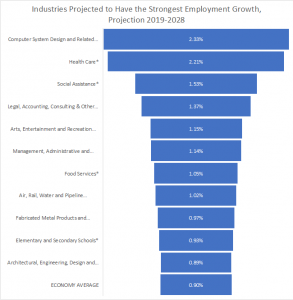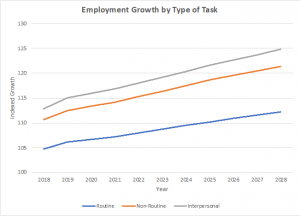Chapter 2: The Job Market
2.3 Projecting Job Growth in Canada
The Canadian government uses the NOC codes and industry statistical information to project job growth in a system called the Canadian Occupational Projection System. The Canadian Occupational Projection System (COPS) combines assessment of recent labour market conditions and projections of labour supply and demand to project future job shortages or surplus.
In the projections for a period from 2019 to 2028, COPS created 293 occupational groupings from 500 different occupations (from NOC). If an occupation with a NOC code had less than 10,000 workers in 2019, they were not used for the projection. COPS projects over the next 10 years, 1.7 million new jobs, will be created which is on average 174,000 jobs per year.
Note as of May 2023, COPS have not yet incorporated the new 2021 NOC codes. Therefore the data below is not changed from the first edition of this book and refers to the 2016 NOC codes. By referring to the COPS code name, you will be able to connect this data to the 2021 NOC codes listed earlier in this chapter.
Projected Employment Growth 2019 – 2028
| COPS Code & Name | Employment (2018) | Employment Growth (2019-2028) |
Future Labour Market Conditions (2019 - 28) |
|---|---|---|---|
| O510 Managers in art, culture, recreation and sport (incl NOC 0513) |
15400 | 600 | Balance |
| 3143 Occupational therapists & Other professional occupations in therapy and assessment |
26800 | 8000 | Shortage |
| 4166 Education, Recreation, Sports and Fitness Policy Researchers, Consultants and Program officers (incl NOC 4167) |
31400 | 3700 | Balance |
| 5250 Athletes, coaches, referees, and related occupations (incl NOC 5254) |
148800 | 20100 | Balance |
| 6530 Tourism and amusement services occupations (incl NOC 6532) |
16800 | 300 | Balance |
| 6720 Support occupations in accommodation, travel and amusement services (incl NOC 6722) |
52100 | 5900 | Balance |
| Total | 291300 | 38600 |
Definitions:
| Balance | means balance between job openings and job seekers |
| Shortage | means more job openings than job seekers |
| Employment | persons 15yrs and over who had a job |
| Employment Growth | annual change of employment (projected for 2019 – 2028) |
Source: COPS Summary 2019 – 2028
Statistics Canada also uses the COPS data to examine and predict job growth by industry as industry is used to examine global trade. In Canada we use the North American Industry Classification System. This is a standardized classification for US, Canada and Mexico (NAICS 2022 version 1.0) originally created for the North American Free Trade Agreement. For more information on NAICS, you can go to https://www.statcan.gc.ca/en/subjects/standard/naics/2022/v1/introduction
The NAICS consists of 20 sectors which represent 695 industries. The industries are identified by their principal activity defined as their main profitable endeavour. For a list of the 20 sectors with their definitions go to NAICS – Canada 2022
Of interest to the Recreation and Leisure Industry is Code 71: Arts, entertainment, and recreation:
“This sector comprises establishments primarily engaged in operating facilities or providing services to meet the cultural, entertainment and recreational interests of their patrons. These establishments produce, promote or participate in live performances, events or exhibits intended for public viewing; provide the artistic, creative and technical skills necessary for the production of artistic products and live performances; preserve and exhibit objects and sites of historical, cultural or educational interest; and operate facilities or provide services that enable patrons to participate in sports or recreational activities or pursue amusement, hobbies and leisure-time interests. There are establishments engaged in activities related to arts and recreation that are classified in other sectors of NAICS” (Statistics Canada, 2022).
As you can see by the above description, even NAICS notes that jobs in Recreation and Leisure cross multiple industries.
Employment Growth Projections
Source: ESDC 2019 COPS industrial projections.
Recreation and Leisure Industry jobs can be found across 3 of the above industries: Health Care, Social Assistance, and Arts Entertainment and Recreation. All 3 of these industries are above average in predicted employment growth 2019 – 2028. This means that there are currently jobs available for graduates of Recreation and Leisure Services programs and as there is predicted job growth across nearly all the areas of the industry, there will be a demand for graduates in the future.
For example, in NOC 3143, Occupational therapists & Other professional occupations in therapy and assessment (includes recreational therapist), there is a 2.6% predicted growth rate 2019 – 2028. This is higher than the general industry of Health Care.
This chart shows the highest expected job growth predicted is in jobs that entail interpersonal tasks (jobs in the Recreation and Leisure Industry fall under interpersonal tasks).
Source: ESDC 2019 COPS Projections.
Routine = repeating of same manual or cognitive tasks
Non-Routine = cognitive analytical and interpretation tasks, thinking creatively
Interpersonal = establishing and maintaining relationships, guiding, coaching, directing, motivating others
For more in depth and up to date information on the labour market trends in Ontario go to https://www.jobbank.gc.ca/trend-analysis/job-market-reports/ontario
Based on the data collected by Statistics Canada and their job growth projections, choosing a career in the Recreation and Leisure industry is an excellent career path with expanding opportunities for employment.



